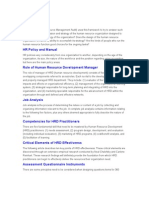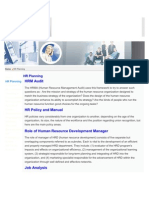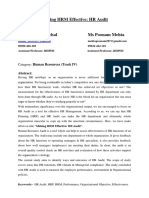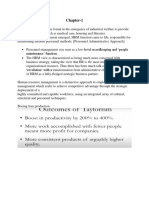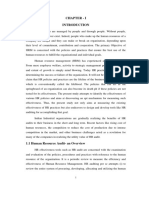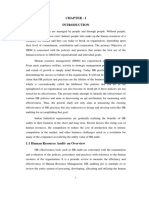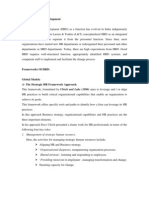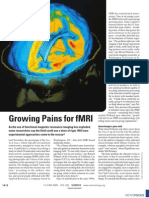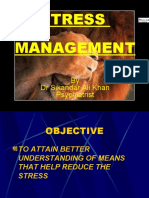HRM in A Glance
HRM in A Glance
Uploaded by
Vineet JustaCopyright:
Available Formats
HRM in A Glance
HRM in A Glance
Uploaded by
Vineet JustaOriginal Title
Copyright
Available Formats
Share this document
Did you find this document useful?
Is this content inappropriate?
Copyright:
Available Formats
HRM in A Glance
HRM in A Glance
Uploaded by
Vineet JustaCopyright:
Available Formats
HR Planning
HRM Audit The HRMA (Human Resource Management Audit) uses this framework to try to answer such questions as : Are the mission and strategy of the human resource organization designed to match the business strategy of the organization? Does the design of the human resource organization enhance its ability to accomplish its strategy? Are the kinds of people who run the human resource function good choices for the ongoing tasks? HR Policy and Manual HR policies vary considerably from one organization to another, depending on the age of the organization, its size, the nature of the workforce and the position regarding union recognition, but here are the main policy areas. Role of Human Resource Development Manager The role of manager of HRD (human resource development) consists of five separate but overlapping components referred to as subroles. Each is vital to the development of an efficient and properly managed HRD department. They include: (1) evaluator of the HRD program's impacts and effects on organizational efficiency, (2) management of the organizational learning system, (3) strategist responsible for long-term planning and integrating of HRD into the organization, and (4) marketing specialist responsible for the advancement of HRD within the organization through well defined and effective networks. Job Analysis Job analysis is the process of determining the nature or content of a job by collecting and organizing information relevant to the job. A complete job analysis contains information relating to the following five factors, plus any others deemed appropriate to fully describe the nature of the job. Assessment Questionnaire Instruments There are some principles need to be considered when designing questions items for 360 degree assessment questionnaire. To be useful, they must be constructed carefully. A simple way to test each of your items is to ask if the item can be described as the following. Critical Elements of HRD Effectivenss The following article describes ten key points of HRD effectiveness. These critical elements are discovered through an extensive empirical research conducted by Neal Chalofsky and Carlene Reinhart. These research findings will definitely provide the foundation from which HRD practitioners can begin to effectively deliver the resources their organization need. Competencies for HRD Practitioners There are five fundamental skill that need to be mastered by Human Resource Development (HRD) practitioners: (1) needs assessment, (2) program design, development, and evaluation (including individual evaluation), (3) marketing of HRD programs, (4) cost/benefit analysis, and (5) facilitation of learning. The Role of HRM in Knowledge Management
There are several roles that can be played by HR in developing knowledge management system. First, HR should help the organization articulate the purpose of the knowledge management system. Investing in a knowledge management initiative without a clear sense of purpose is like investing in an expensive camera that has far more capabilities than you need to take good pictures of family and friends. Redefining The Role of Strategic HR Redefining the role of strategic HR can be challenging. Here are some reasons. HR may not have credibility with senior managers. Many executives do not view HR as a business. They are used to thinking of HR as an organizational support department and accustomed to telling them what to do. HR will need to achieve the credibility to be accepted in the new role. Key Components of Human Resource Development There are three fundamental component areas of human resource development (HRD): individual development (personal), career development (professional), and organizational development. The importance of each component will vary from organization to organization according to the complexity of the operation, the criticality of human resources to organizational efficiency, and the organization's commitment to improved human resources. Position Analysis Questionnaire (PAQ) This is one of the most sophisticated and yet easily administered techniques to analyze job. The PAQ analyzes jobs in terms of 187 job elements. These elements are of a worker-oriented nature, meaning that they characterize or imply the human behaviors that are involved in various jobs. Work Measurement Methods The purpose of work measurement is to determine the time it ought to take to do a job.There are four main systems of work measurement. First, and most used, is time study. The second system, work sampling, is a statistical procedure for measuring work and requires an understanding of the techniques of statistics and probability. Job Analysis Interview Guide Job analysis interview guide is a tool that can be used in conducting job analysis process. It describes list of questions that should be asked to explore the content of a particular job. What is the job's overall purpose? What the incumbent does and, if possible, how he/she does it? Writing Job Description Most widely used job description formats contain the following five sections: (1) job identification; (2) job summary or purpose; (3) job duties and responsibilities; (4) accountabilities; and (5) job specifications. The most important thing to remember is that all job descriptions within an organization should follow the same format. Strategies for Designing and HRD Program Jerry Gillet and Seteven Eggland (2002) identified for managers of HRD an eight-point strategy for designing cost-effective, reputable learning programs that can survive economic crises and internal/external changes affecting the organization. First, there should be a written HRD philosophy that states unequivocally that effective human resource development can improve performance (i.e., change behavior, produce results, increase productivity). This provides a
framework for the HRD program. It also provides a common objective for each of the members of the HRD staff on which to focus their efforts. Job Time Study Time study is a work measurement technique for recording the times of performing a certain specific job or its elements carried out under specified conditions, and for analyzing the data so as to obtain the time necessary for an operator to carry it out at a defined rate of performance. Work Study and Employee Productivity Work study is the systematic examination of the methods of carrying on activities so as to improve the effective use of resources and to set up standards of performance for the activities being carried out. Work study then aims at examining the way an activity is being carried out, simplifying or modifying the method of operation to reduce unnecessary or excess work, or the wasteful use of resources, and setting up a time standard for performing that activity. Characteristics of Effective HRD Managers Nadler and Wiggs (1986) identified nine characteristics of effective HRD (human resource development) managers. Each is viewed as essential to the development of a comprehensive and competent HRD program. First, HRD managers must have the ability to plan HRD activities that foster training, development, and education. These activities should be targeted at the needs of employees, supervisors, line managers, customers, and nonemployees of the organization.
Selection + Recruitment
Key Indicators for Recruitment Process A number of factors exert an influence over the kind of recruiting plan an organization enacts. These factors include (1) organizational policies regarding recruiting; (2) type of labor to be recruited; (3) conditions of the labor market; and (4) cost and time constraints. Types of Selection Methods Selection methods or screening devices include employment interviews and personality test. The employment interview is a vehicle for information exchange between applicant and interviewer regarding an applicant's suitability and interest in a job the employer seeks to fill. Recruitment and Job Analysis Job analysis provides important inputs to the recruiting function in two ways. First, job analysis provides job specifications, the personal requirements deemed necessary to perform each job in an organization. This tells planners and recruiters exactly what skills, abilities, experience, and other physical characteristics will be needed for certain jobs. Validity of Selection Method If selection methods are invalid, employee selection decisions are no more accurate than decisions based on a toss of a coin. Validity is the degree to which a measure accurately predicts job performance. Selection methods are valid to the extent that predictors measure or are significantly related to work behavior, job products, or outcomes. Realistic Job Preview (RJP)
The realistic job preview (RJP), a new concept in recruiting and selection, is a method of communicating to an applicant or new employee what it will be like to actually perform a certain job. RJPs perform a valuable function in employee orientation, reducing reality shock and thus speeding the socialization process.
Validity of Appraisal Instrument Regardless of an organization's specific needs for performance appraisal, five general requirements must be met by an appraisal system if it is to accomplish its objectives: reliability, validity, practicality, fairness, and impact. Reliability is the consistency of a measure over time and across different raters. Consistency over time means that at any two points in time, an instrument should yield the same findings or results. Selection Error There are two types of selection error. In the "false positive error," a decision is made to hire an applicant based on predicted success, but failure results. In the "false negative error," an applicant who would have succeeded is rejected based on predictions of failure. An organization that makes a false positive error incurs three types of costs. The first type of costs are those incurred while the person is employed. Utility of Selection Utility refers to the overall usefulness of a personnel selection or placement procedure. The concept encompasses both the accuracy and the importance of personnel decisions. Moreover, utility implies a concern with costs? costs related to setting up and implementing personnel selection procedures and costs associated with errors in the decisions made. Talent Brand The challenge to attract attention by differentiating yourself is not a new one, of course. When it comes to their product or service brands, organizations, especially large companies, generally "get it." In hotly competitive industries, such as retail, companies spend millions establishing their name and creating a strong brand image that compels consumers to reach for their products. Unfortunately, many times companies have not put the same effort into making sure the overall brand is carried through in their efforts to communicate with Great Talent.
Training + DevelopmentTypes of Training Program
Types of learning can be categorized into three groups. The first type is cognitive learning or knowledge learning. It not only includes the knowledge per se, but also what to do with it or how to apply it. Thus the investigative process and the principles of problem solving and decision making are part of this group. Training Need Analysis There are three types of training need analysis : organizational need analysis, job need analysis, and person need analysis. Organizational need analysis begins with an examination of the short and long-term objectives of the organization and the trends that are likely to affect these objectives. Training Scorecard
When implementing a training scorecard it is important to track, collect, compile, analyze, and report six different types of training data collected over different time periods. These types of data are indicators, reaction, learning, application, business impact, and return-on-investment. Four Ways to Maximize Learning Retention As you design your presentation, remember that your instructional goal is to maximize the participants' understanding and retention of the subject matter. Ultimately, the participants will learn more if they can focus their attention on the subject matter and make the ideas relevant to themselves. Four ways to maximize understanding and retention follow; try to use some or all of them as you present your lecture. Designing Lesson Plan Designing the course involves actually deciding on a plan of action, i.e. a lesson or session plan. This provides you with the orderly procedures for conducting or facilitating a session efficiently. It should not be long (two pages at the most) but should be complete and practical. It should be written or sectioned in a format that is helpful and meaningful to you, the trainer, and it should give you confidence not only is it proof that you have prepared adequately, but it is your 'prop' if you need it. Optimizing Learning Process Following employees' exposure to training and development experiences, the environment needs to support the transfer of new behaviors to the job, and their maintenance over time.The following learning principles should be undertaken to increase the success of training. First, providing clear Expectations. If task instructions are unclear or imprecise, learning is hampered. Employees must know what is expected in order to perform as desired. Training expectations should be stated in specific terms. Learning Objective and Training Content Learning objectives have also been called performance objectives and behavioral objectives. Whatever the terminology, objectives must be clearly defined. An objective is a precise goal stated in measurable quantitative or qualitative terms. It is of little use to you in designing a course if vague, woolly terminology is used in defining the objectives. Andragogy Learning Method The term andragogy was used to differentiate it from the theory of youth learning, pefagogy. This term was used by Malcolm Knowles in his work of developing a unified system of adult learning. It is essentially a process model and is based around the premise that, as an individual matures, his/her need and capacity to be self-directing, to utilize his/her experience in learning, to identify his/her own readiness to learn, and to organize his/her learning around life problems, increases steadily from infancy to pre-adolescence and then increase rapidly during adolescence. HRD Learning Activities HRD or Human Resource Development can best be described as a comprehensive learning system designed to enhance individual performance for the purpose of improving organizational efficiency. As such, HRD includes three types of learning activities: on the job, off the job, and through the job. A Model for Great Mentoring
Great mentoring process requires four core competencies, each of which can be applied in many ways. These competencies form the sequential steps in the process of mentoring. All four have been selected for their ability to blend effectively with. Not accidentally, the first letters of these four competencies (and steps) spell the word SAGE a helpful mnemonic as well as a symbolic representation of the goal, the power-free facilitation of learning. Experiencing Work-based Learning How can we introduce learning as an organizational property that extends to all managers? The answer lies in making learning arise from the work itself. Learning has to become natural, even fun. Unfortunately, we have become conditioned to a classroom model hat separates theory from practice, making learning seem impractical, irrelevant, and boring. But what if we make our worksite a perfectly acceptable location for learning? The Qualities of Great Mentoring Great mentors are not immune to traps; great mentors recognize the traps they are likely to fall into and work hard to compensate for them. How do they do that? They do it by understanding the qualities of a mentor-protege relationship focused on discovery and learner independence and then learning to be living, breathing models of those qualities. First and foremost, great mentoring is a partnership. And partnership starts with balance.
Performance Appraisal
Evaluation Criteria in Performance Appraisal In choosing an appraisal system, HR professionals should consider their own organization's needs for performance appraisal. Key considerations are (1) whom the company should evaluate, and (2) what criteria should be used to evaluate. 8 Steps to Higher Performance The following eight steps will help you and your employees interact in ways that make you work more efficiently and effectively. These steps will help you help your employees feel more motivated on the job and build the connection between their own interests and the interests of the organization. Performance Coaching Process There's no one single script you can develop that will ensure productive, effective performance appraisal interviews. But avoiding the following five common interviewing errors will give you a good margin for success : 1) Failure to prepare for the interview. This is the number one reason why appraisal interviews fail. You and the employee should know what the job requirements are, and how the employee is meeting them, before you even schedule the interview. Giving Negative Feedback When negative feedback is necessary, the best time to give it is now before the problem gets any worse. Early attention to developing problems lets you turn the painful experience of negative feedback into the more constructive process of corrective feedback. Developing Peak Performers Extensive research into peak performers in all walks of life shows that they have very similar ways of thinking about themselves and others. They share other similar mindsets, too. Because of
this, they operate in similar ways. This article explains what we know about peak performers, whether in business, public service, private life, school, athletics, or team pursuits. People who adopt these four mindsets and approaches to life become peak performers, too. Personal Characteristics in Performance Appraisal Process Does a relationship between the personal characteristics of the rater and the ratee affect the favorability of the rating? Rand and Wexley used a simulated employment interview to help answer that question. Although the employment interview and performance appraisal are two separate aspects of the human resource function, they have a similarity that seems appropriate to the question. Developing Feedback Skills The purposes of this article are to show you the importance of providing both positive and negative feedback and to identify specific techniques to help make your feedback more effective.Positive feedback is more readily and accurately perceived than negative feedback. Furthermore, while positive feedback is almost always accepted, negative feedback often meets resistance. The Attributes of a Good Coach A good coach is positive, enthusiastic, supportive, trusting, focused, goal-oriented, knowledgeable, observant, respectful, patient, and clear. Let's look at how each characteristic comes into play in the workplace. A good coach is positive. Your job is not correcting mistakes, finding fault, and assessing blame. Instead, your function is achieving productivity goals by coaching your staff to peak performance. Appraising Team Performance The primary dilemma with performance appraisals and teams is that appraisal forms and processes were built with individuals in mind. Using an individually based instrument to measure the performance of a team is difficult. Where does the work of the individual stop and the team begin? The appraisal job gets even tougher when the teams are cross-functional, not homogeneous. Executive Coaching and Business Strategy Successful executive coaching requires sophisticated understanding of organizations as well as of individuals. Nowhere is that more apparent than in the intersection of business strategy and the executive coaching that supports it. Senior leaders play a critical role in setting direction, defining strategic positions, and providing focus for the business operations needed for successful execution. Through executive coaching, a leader can be more effective, as an individual, in guiding the execution of the strategy. Framework for the Strategic Executive Coaching Process This article describes the process component of executive coaching by breaking it down into five key steps. The exact determination of dividing lines between the individual steps is less important than the approach to issues that arise during the process as a whole. In step one: Careful Contracting, we should create a trusting environment in which open dialog can occur and underlying issues can be brought to light. A great deal of honest communication and feedback will set the parameters of the executive coaching process.
Traps to Avoid in Mentoring Process There are countless traps along the path of mentordom. Mentoring can be a power trip for those seeking an admirer, a manifestation of greed for those who must have slaves. Mentoring can be a platform for proselytizing a cause or crusade, a strong tale told to an innocent or unknowing listener. However, the traps of power, greed, and crusading all pale when compared with the subtler description listed below. There are other traps, of course, but these are the ones that most frequently raise their ugly heads to sabotage healthy relationships. Seven Roles of Managers in the Performance Review Meeting Performance review is the final phase of an effective performance management system. It involves the individual and the manager discussing the performance appraisal document that the manager has created. The performance management process both ends and begins anew with the performance review meeting. At the beginning of the meeting, the individual's past year's performance is reviewed and the success of the development plan is evaluated. At the end of the meeting, the appraiser and the individual set a date to create the plan for next year's goals, objectives, and development. Six Roles of Employees in the Performance Review Meeting Wise managers ask each of their subordinates to create an accomplishments list to begin the performance assessment phase. This list is intended to provide the manager with a record of those achievements and accomplishments that the individual felt were the most important during the appraisal period. In the meeting, the individual should review the accomplishments list he prepared to make sure that the appraiser has appropriately incorporated his achievements during the review period.
Career Management
Career Development Program Has your organization seriously considered implementing a career development program? If not, perhaps this is a good time to do so. The following description of several, widely used career development interventions and case studies can be used to stimulate discussion on various career development practices. Elements of Career Planning Programs Though programs differ, four distinct elements of career planning programs emerge. They include (1) individual assessments of abilities, interests, career needs, and goals; (2) organizational assessments of employee abilities and potential; (3) communication of information concerning career options and opportunities with the organization; and (4) career counseling to set realistic goals and plan for their attainment. Career Anchor and Career Stage Schein's career anchors represent aspects of work that are especially valued or needed by people for their personal fulfillment. Career planning and development activities allow employees to grow in any of these desired anchors. Key Steps in Career Development Initiatives To "hit the bull's-eye," you need to talk with employees to find out what's missing. Is it lack of perceived opportunity, not enough training, too little communication, diversity issues? Exit
interview analysis, employee surveys, and focus groups can help you become clearer about employees' views on these issues. Self Assessment of Career Interest Do you need to develop some new skills or abilities to improve your potential for your next step ? If so, what skills or abilities would you develop ? Summarize what you personally want and what you can do and will do to satisfy your wants. These are some examples of self assessment questions to explore your career interest. The Rules for Corporate Career Resilience Rule #1: The company is not in charge of your careeryou are. Your people can no longer wait for you to come to them with a new assignment or opportunity; they must seek out such opportunities themselves. Your relationship with them is no longer one of parent-to-child, but adult-to-adult. They share the responsibility for initiating career discussions.
Organization Analysis
Types of OD Intervention Interventions that define is delivered when people are unclear, disagree, or have different expectations; there are conflicting objectives; or people do not have a shared understanding. Examples: holding sessions to create vision statements; confirming market direction and market niche; mutually setting performance goals. Five Steps for Effective Change Process Organizational change involves moving from the known to the unknown. Because the future is uncertain and may adversely affect people's competencies, worth, and coping abilities, organization members generally do not support change unless compelling reasons convince them to do so. Overcoming Resistance to Change Resistance can be reduced through communicating with employees to help them see the logic of a change. This tactic basically assumes that the source of resistance lies in misinformation or poor communication: If employees receive the full facts and get any misunderstandings cleared up, resistance will subside. Communication can be achieved through one-on-one discussions, memos, group presentations, or reports. Four Dimensions of A High Performance Organization A high-performance organization is comprised of four interdependent dimensions that must be designed so they complement and support one another. These elements are : work process and technology, culture, structure, and people. One clear finding is that the greater the number of the key elements of a high-performance organization that were present and congruent, the bigger the pay-off. Job Satisfaction What work-related variables determine job satisfaction? An extensive review of the literature indicates that the more important factors conducive to job satisfaction are mentally challenging work, equitable rewards, supportive working conditions, and supportive colleagues.
Leading Corporate Transformation Successful corporate transformations share a few fundamental attributes. First, they are vision led. Transformational change, as contrasted with incremental change, requires a projection into a dimly lit future. It involves the creation of goals that "stretch" the organization beyond its current comprehension and capabilities. The Major Families of OD Interventions Not all OD programs contain all the possible intervention activities, but a wide range of activities is available to the practitioner. As we see it, the following are the major "families" or types of OD interventions. Four Elements to Empower Employees Much has been written about empowering employeesto the point of becoming a clichebut far too many companies pay little more than lip service to the subject or else give employees more responsibility but little compensation or strategic direction from leaders. Why? Despite all the literature and conferences on this subject, top management still has little understanding of delegation and even little desire to delegate authority/power to fully empower employees. A Great Place to Work The following description section explores four key elements to create a great place to work. Element one is : A Friendly Place. It may sound trite, but friendliness appears to be one of the distinguishing characteristics of good workplaces. People seem to enjoy each other's company. This is not an insignificant issue. Work for an organization is, after all, work in a group setting. Employee Satisfaction and Customer Loyalty Virtually all of the studies that tested the satisfaction mirror concept have identified some linkage between employee satisfaction and customer satisfaction, between employee satisfaction and customer loyalty, or both. The discovered linkages, however, have ranged from negative to positive, and a few studies yielded no correlation at all. The necessary conclusion? Employee satisfaction does not universally nor unambiguously create customer loyalty. OD Intervention Success Indicators Institutionalizing an OD intervention concerns refreezing. It involves the long-term persistence of organizational changes: to the extent that changes persist, they can be said to be institutionalized. Such changes are not dependent on any one person but exist as a part of the culture of an organization. This means that numerous others share norms about the appropriateness of the changes. Critical Characteristics of OD The essential point in calling OD a process is to characterize it as a dynamic, moving, changing thing. People learn new skills and forget old ones; the structure of the organization changes, and then another change is put on top of that; problems are solved and new ones develop; a sick subsystem gets well and a heretofore healthy one develops bad symptoms. Individual and Organizational Resistance As human beings, we're creatures of habit. Life is complex enough; we don't need to consider the full range of options for the hundreds of decisions we have to make every day. To cope with this
complexity, we all rely on habits or programmed responses. But when confronted with change, this tendency to respond in our accustomed ways becomes a source of resistance. Keeping a Corporate Culture Alive Once a corporate culture is in place, there are practices within the organization that act to maintain it by giving employees a set of similar experiences. For example, many of the human resource practices reinforce the organization's culture. The selection process, performance evaluation criteria, reward practices, training and career development activities, and promotion procedures ensure that those hired fit in with the culture, reward those who support it, and penalize (and even expel) those who challenge it. Change Management: The Need for Action The why question is not always easy to answer, particularly if the company is profitable and there are no apparent problems. You have to convince people that you are preparing for the future, not attempting to remedy the past. In addressing this first priority, how you choose to launch your action program is a critical decision. In most cases, the longer-duration decathlons and marathons are best launched in a low-key way. Because of the often lengthy time between the start of actions and the point at which actions actually pay off, it is better not to raise interest and expectations too high if no immediate steps are required. The Characteristics of a Learning Company Since a Learning Company seeks to delight its customers, it will engage in a number of mutually advantageous learning activities. Joint training, sharing in investment, in research and development, job exchanges - these are just some of the ways in which this takes place. The corollary, of course, is that it also joins with its suppliers in these activities. We can also learn from companies in other industries - a process often known as "benchmarking". Clarifying Vision for Change The key questions you must address as you begin communication to clarify the vision for your action include the following: 1) What exactly is the vision, why this vision and not another? 2) How does this action fit with our strategy and with other initiatives going on? and 3)How will our work be different?
Personal Development
Seven Communication Principles To compose effective message you need to apply certain specific communication principles. They tie closely with the basic concepts of the communication process and are important for both written and oral communications. Called the seven Cs, they are: completeness, conciseness, consideration, concreteness, clarity, courtesy, and correctness. 8 Qualities of Success Person The motivation to succeed comes from the burning desire to achieve a purpose. Napoleon Hill wrote, "Whatever the mind of man can conceive and believe, the mind can achieve." A burning desire is the starting point of all accomplishment. Just like a small fire cannot give much heat, a weak desire cannot produce great results. Dealing with Different Personalities There are four major archetype of personalities: dominance, influence, steadiness, and conscientiousness style. People of the Dominance Style like to control their environment by
overcoming opposition to accomplish desired results. They enjoy moving people around in their favor. They are direct, forceful, impatient, and opinionated. They enjoy being in charge, making decisions, solving problems, and getting things done. They tend to thrive on power, prestige, and authority, and they can be extremely demanding. Developing Active Listening Skills The ability to be an effective listener is too often taken for granted. We confuse hearing with listening. Hearing is merely picking up sound vibrations. Listening is making sense of what we hear. Listening requires paying attention, interpreting, and remembering sound stimuli. Managing Conflict The ability to manage conflict is undoubtedly one of the most important interpersonal skills a manager needs. Over the years, three differing views have evolved regarding conflict in organizations. One view argues that conflict must be avoided, that it indicates a malfunctioning within the organization. We call this the traditional view of conflict. Why We Fail? When problems seem insurmountable, quitting seems to be the easiest way out. It is true for every marriage, job and relationship. Winners are struck but not destroyed. We all have had setbacks in life. Failing does not mean we are failures. Visualize for Success When you see yourself in your mind's eye doing something, do you imagine accomplishments, tributes and triumphs or flops, failures and fiascos? Visualizing can work for us or against us. It depends on what we picture-success or failure. We've all heard the saying 'Practice makes perfect'. Actually, only perfect practice makes perfect. And where is the only place we can practice perfection? In our mind's eye. Leaders as Team Builder Nothing influences behavior more than your behavior at the top. You are the role model and your actions, not the slogans on the wall, will influence how others behave. A collaborative environment that encourages working together for a common purpose, within and among teams, is important to your organization's success. Goals and Focus for Success We've seen that, to generate more of what we want, we first need positive, empowering beliefs about ourselves and others. We need clear and specific goals to aim for. And we need to take action aimed at achieving the results we want. The Elements of a Good Coaching Session To conduct a good coaching session, you need to (1) establish a purpose, (2) establish ground rules, (3) keep focused, (4) avoid monologues, (5) speak clearly and simply, and (6) stay open to new ideas. Let's look more closely at each of these six elements of a good coaching session. Effective Delegation Skills
Managers get things done through other people. This description recognizes that there are limits to any manager's time and knowledge. Effective managers, therefore, need to understand the value of allocating task (delegating) and know how to do it. Building Productive Communication Productive communication is problem-oriented, not person oriented. Person-oriented communication focuses on the characteristics of the individual, not the event, and it communicates the impression that the individual is inadequate. One problem with personoriented communication is that, while most people can change their behavior, few can change their basic personalities. Building a Sense of Competence To develop you members performance, you need to build a sense of competence among your team members. There are five strategies to accomplish this: providing knowledge, giving positive feedback, skill recognition, challenge, and high, non comparative standards. Leaders as Inspiration Stimulator What exactly does it mean to inspire others? It means creating conditions that cause people around you to feel excited and energized about being part of your team. Although you can't "install" inspiration in others, you can plant the seeds and create the right conditions for it to grow. Leading for Meaningfulness To become a great leader, you should be able to build a sense of meaningfulness among your members. There are four core strategies that can be deployed to instill a sense of meaningfulness: clearly identified passions, exciting vision, relevant task purposes and whole tasks. How to Deal With Plateauing? Plateauing is a concept that says when a major aspect of life has stabilized, as it ultimately must, we may feel significantly dissatisfied. The essential source of the dissatisfaction is that the present is not engrossing and the future is not clear. There is not yet an answer to the question "What will I do next?" People who are plateauing are at a levelthey are neither rising nor falling.
You might also like
- HR Audit ProjectDocument39 pagesHR Audit Projectdan_cool78678% (46)
- Solfege On The StaffDocument3 pagesSolfege On The StaffElvin Negron100% (2)
- HR AuditDocument26 pagesHR AuditSujeet Mundari50% (2)
- The HR Scorecard (Review and Analysis of Becker, Huselid and Ulrich's Book)From EverandThe HR Scorecard (Review and Analysis of Becker, Huselid and Ulrich's Book)Rating: 5 out of 5 stars5/5 (1)
- HRM Audit: HR PlanningDocument8 pagesHRM Audit: HR Planningedmondkera1974No ratings yet
- HR PlanningDocument3 pagesHR PlanningBasavanna S BasavannaNo ratings yet
- HRM Audit: HR PlanningDocument4 pagesHRM Audit: HR PlanningmahadevrdNo ratings yet
- Making HRM Effective: HR Audit: Category: Human Resources (Track IV)Document14 pagesMaking HRM Effective: HR Audit: Category: Human Resources (Track IV)Irfan A. FaridiNo ratings yet
- HR Audit Set 1Document11 pagesHR Audit Set 1Zayed PatelNo ratings yet
- Project HR AuditDocument8 pagesProject HR AuditSmita AvhadNo ratings yet
- Sessional 2Document8 pagesSessional 2High BpNo ratings yet
- Human Resource AuditDocument7 pagesHuman Resource AuditvidushiparikhNo ratings yet
- Job Analysis 2009Document77 pagesJob Analysis 2009irfanbasha2050No ratings yet
- Human Resources AuditDocument5 pagesHuman Resources AuditSthita P S JenaNo ratings yet
- Week 2 Strategic Human Resource ManagementDocument8 pagesWeek 2 Strategic Human Resource ManagementBasitAliJadoonNo ratings yet
- Human Resource PlanningDocument7 pagesHuman Resource PlanningJasper DelacruzNo ratings yet
- Human Resources Management SEM-II (GTU)Document105 pagesHuman Resources Management SEM-II (GTU)anon_7887288710% (2)
- Unit 1 HRMDocument21 pagesUnit 1 HRMmayankNo ratings yet
- Evaluating A Successful Human Resource Management PlanDocument18 pagesEvaluating A Successful Human Resource Management Plansheebakbs5144No ratings yet
- Effective Job Analysis 2Document15 pagesEffective Job Analysis 2sohaib0786100% (1)
- HR Gd-Pi Guide - 2015: Compiled by HR DirectionDocument11 pagesHR Gd-Pi Guide - 2015: Compiled by HR DirectionKhyati DahiyaNo ratings yet
- Dawar Shoe Recruitment and SelectionDocument131 pagesDawar Shoe Recruitment and SelectionsuryakantshrotriyaNo ratings yet
- Essential of HRM AssignmentDocument4 pagesEssential of HRM Assignmentbs357192No ratings yet
- Chapter 1Document16 pagesChapter 1Ashekin MahadiNo ratings yet
- BSBHRM602 Powerpoint PresentationDocument95 pagesBSBHRM602 Powerpoint PresentationJazz100% (1)
- 7 Human Resource Management Basics Every HR ProfessionalDocument18 pages7 Human Resource Management Basics Every HR ProfessionalpaopaoarevaloNo ratings yet
- Chapter I CombinedDocument224 pagesChapter I Combinedxetato6515No ratings yet
- Chapter IDocument8 pagesChapter Ixetato6515No ratings yet
- Mu0013 - HR AuditDocument13 pagesMu0013 - HR AuditArunNo ratings yet
- Chapter 04Document25 pagesChapter 04Ehsan VillaNo ratings yet
- HR AuditDocument5 pagesHR AuditshanumanuranuNo ratings yet
- HRM Unit 2Document28 pagesHRM Unit 2notshivomNo ratings yet
- HRM SummaryDocument8 pagesHRM SummaryElla Mae BatallerNo ratings yet
- HR - Dehradun Priyanka BagwaniDocument39 pagesHR - Dehradun Priyanka BagwaniANKIT SINGH RAWATNo ratings yet
- Pub3712 Assignment 5 NotesDocument53 pagesPub3712 Assignment 5 NotesTsholofelo Majipos StlhanohNo ratings yet
- Unit Learning 1 1 Strategic Role of HRMDocument6 pagesUnit Learning 1 1 Strategic Role of HRMCharan AdharNo ratings yet
- MU0013Document12 pagesMU0013Mrinal KalitaNo ratings yet
- HR Gd-Pi Guide-2018: Compiled by HR DirectionDocument11 pagesHR Gd-Pi Guide-2018: Compiled by HR DirectionSubhendu PradhanNo ratings yet
- SHRM Ques & Ans - 2023Document8 pagesSHRM Ques & Ans - 2023workhome starNo ratings yet
- HR Compendium-2018: Compiled by HR DirectionDocument11 pagesHR Compendium-2018: Compiled by HR DirectionSudiv GullaNo ratings yet
- HRD AssignmentDocument17 pagesHRD AssignmentKarpagam Chandrasekaran67% (3)
- HR Analytics 1Document9 pagesHR Analytics 1NikkiNo ratings yet
- Chapter Five Staffing 5.1 DefinitionDocument9 pagesChapter Five Staffing 5.1 DefinitionMagarsa BedasaNo ratings yet
- A Study On Performance Appraisal System in Stanley Material and Metallurgical Pipe and Tube Manufacturing Industry at CoimbatoreDocument36 pagesA Study On Performance Appraisal System in Stanley Material and Metallurgical Pipe and Tube Manufacturing Industry at Coimbatorek eswariNo ratings yet
- HRM Lecture NotesDocument29 pagesHRM Lecture NotesJolyn LeeNo ratings yet
- HRD Strategies For Long Term Planning & Growth: Unit-9Document28 pagesHRD Strategies For Long Term Planning & Growth: Unit-9rdeepak99No ratings yet
- Human Resource Planning and Audit - A Case Study of HEG LimitedDocument19 pagesHuman Resource Planning and Audit - A Case Study of HEG LimitedLawrence LubigiliNo ratings yet
- HRM Individual EssayDocument9 pagesHRM Individual EssaykunalNo ratings yet
- Job Analysis in Human Resources ManagementDocument13 pagesJob Analysis in Human Resources ManagementNolzen Torres100% (1)
- HAHAHADocument7 pagesHAHAHAkatedutta2No ratings yet
- HRM Introduction To HRMDocument32 pagesHRM Introduction To HRMkoustav chakrabortyNo ratings yet
- Principles of Management II: Chapter Two: Human Resource Management Lecturer: Dr. Mazen RohmiDocument38 pagesPrinciples of Management II: Chapter Two: Human Resource Management Lecturer: Dr. Mazen Rohmihasan jabrNo ratings yet
- Introduction To Human Resource ManagementDocument4 pagesIntroduction To Human Resource Managementyasir habibNo ratings yet
- Ccw331 Unit 4Document33 pagesCcw331 Unit 4juanabhishekNo ratings yet
- Recruitment and SelectionDocument8 pagesRecruitment and SelectionspNo ratings yet
- HRM QuestionsDocument22 pagesHRM QuestionsCharlie MaineNo ratings yet
- Human Resource ManagementDocument17 pagesHuman Resource ManagementOanaa ComanNo ratings yet
- The Simple Side Of Human Resource ManagementFrom EverandThe Simple Side Of Human Resource ManagementRating: 5 out of 5 stars5/5 (5)
- Zodiac Mental DisordersDocument3 pagesZodiac Mental DisordersBrandonNo ratings yet
- Mapeh REPORT ON THE RESULTS OF THE REGIONAL MID YEAR ASSESSMENTDocument4 pagesMapeh REPORT ON THE RESULTS OF THE REGIONAL MID YEAR ASSESSMENTEiron AlmeronNo ratings yet
- Growing Pains For fMRIDocument3 pagesGrowing Pains For fMRIrobgoNo ratings yet
- Elicitation Techniques SelectionDocument10 pagesElicitation Techniques SelectionCarlos JaramilloNo ratings yet
- A STEM CLIL Pilot Project in Ecuadorian High SchoolsDocument3 pagesA STEM CLIL Pilot Project in Ecuadorian High Schoolsaltynsarin.prom.2004No ratings yet
- An Introduction To The Elements of Voice: Based On Nancy Dean'sDocument19 pagesAn Introduction To The Elements of Voice: Based On Nancy Dean'sAkhil PramanikNo ratings yet
- Document PDFDocument245 pagesDocument PDFAlina Ioana StanNo ratings yet
- Unit 5 MotivationDocument62 pagesUnit 5 MotivationNuman KhalidNo ratings yet
- Nea PDFDocument2 pagesNea PDFChen HuaiyuNo ratings yet
- Stress Prsentation by DR Sikandar Ali KhanDocument40 pagesStress Prsentation by DR Sikandar Ali KhanbhailolaNo ratings yet
- Significance of Acad PerfDocument2 pagesSignificance of Acad PerfAireymhel BarriosNo ratings yet
- Module 2Document19 pagesModule 2James DellavaNo ratings yet
- Creating Learning EnvironmentsDocument17 pagesCreating Learning EnvironmentsAin Najihah ASNo ratings yet
- Pratical-Research 3Document9 pagesPratical-Research 3angelarboleda816100% (1)
- Mtu SopDocument2 pagesMtu Sopvinod ramanNo ratings yet
- Research Paper ALTERNATIVE ASSESSMENTDocument8 pagesResearch Paper ALTERNATIVE ASSESSMENTTopacio GervacioNo ratings yet
- Learning - Experiences - English - Phonetic - and - Phonology. - Portfolio 2Document13 pagesLearning - Experiences - English - Phonetic - and - Phonology. - Portfolio 2LADY MADELEY SOLIS CAMPOVERDENo ratings yet
- Sdg9-Chapter 1Document30 pagesSdg9-Chapter 1Victini PikachuNo ratings yet
- Assessment Brief: Module Code: Module Title: Distributed On: Hand in DateDocument14 pagesAssessment Brief: Module Code: Module Title: Distributed On: Hand in DateVamshidhar ReddyNo ratings yet
- NAME: ASUNCION, Seigfreid Miguel M. Course and Year: Bs Mls 1Document2 pagesNAME: ASUNCION, Seigfreid Miguel M. Course and Year: Bs Mls 1Miguel AsuncionNo ratings yet
- Usman Bashir CVDocument3 pagesUsman Bashir CVUsman BashirNo ratings yet
- TEACHING ACROSS AGE LEVEL B EnnyDocument5 pagesTEACHING ACROSS AGE LEVEL B EnnyEhemzzTurobulAqdamNo ratings yet
- Career Development Interventions (PDFDrive) - 82-88Document7 pagesCareer Development Interventions (PDFDrive) - 82-88Wahyu AnggraeniNo ratings yet
- UFSS1522 Education and Career Plan Worksheet - FINALDocument3 pagesUFSS1522 Education and Career Plan Worksheet - FINALliramof1720No ratings yet
- Intercultural Communication Week 1 Power PointDocument58 pagesIntercultural Communication Week 1 Power PointvickygellaNo ratings yet
- CBSE English Class 9 Mid Term Question Paper PatternDocument1 pageCBSE English Class 9 Mid Term Question Paper PatternMr Mineblox 2.0No ratings yet
- Sofia Vaughn Dalaguit - PPT Prof. Ed 8Document25 pagesSofia Vaughn Dalaguit - PPT Prof. Ed 8Sofia VaughnNo ratings yet
- Narvaez Laps Ley TeacherDocument10 pagesNarvaez Laps Ley TeacherShawn LauNo ratings yet
- L D Needs ReportDocument8 pagesL D Needs ReportMark Delos ReyesNo ratings yet




